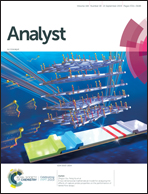Fluorescent fibrous mats assembled with self-propagating probes for visual sensing of hydrogen peroxide and choline
Abstract
Challenges remain in the facile, rapid and sensitive detection of substances at ultralow levels. In the current study, visual sensors of hydrogen peroxide (H2O2) and choline are developed via the integration of an ultrafine fibrous substrate and self-propagating and aggregation-induced emission (AIE) probes. Self-immolative probes (SIPs) composed of phenylboronic acid triggers and choline units are grafted on electrospun polyethylene terephthalate (PET) fibers, followed by electrostatic adsorption of tetraphenylethene derivatives (TPE-SO3) to obtain fluorescent PET-Ch/TPE fibers. Choline oxidase (ChOX) is immobilized on polystyrene-co-maleic anhydride (PSMA) fibers to obtain PSMA-ChOX, followed by assembly into PET-Ch/TPE@PSMA-ChOX composite mats. The presence of H2O2 initiates the cleavage of phenylboronic acid triggers in SIPs to release choline and choline/TPE complexes from PET-Ch/TPE fibers. The released choline is oxidized by PSMA-ChOX fibers to generate H2O2 that then activates a cascade of self-propagating reactions until the release of all choline/TPE complexes, leading to the alleviation of AIE effect and gradual fluorescence fading of fibrous mats. Thus, the hydrogen peroxide and choline concentrations can be read out from the fluorescence fading time of fibrous mats with a detection limit of 0.5 μM H2O2 within 30 min, providing potential self-test devices for a real-time, naked-eye and sensitive detection of bioactive substances.



 Please wait while we load your content...
Please wait while we load your content...